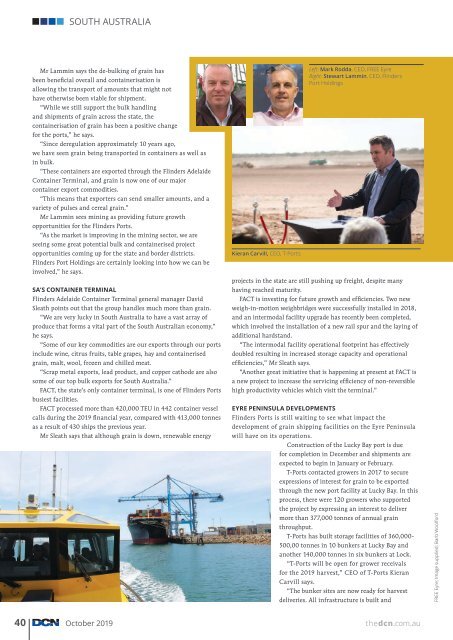DCN October Edition 2019
Create successful ePaper yourself
Turn your PDF publications into a flip-book with our unique Google optimized e-Paper software.
SOUTH AUSTRALIA<br />
Mr Lammin says the de-bulking of grain has<br />
been beneficial overall and containerisation is<br />
allowing the transport of amounts that might not<br />
have otherwise been viable for shipment.<br />
“While we still support the bulk handling<br />
and shipments of grain across the state, the<br />
containerisation of grain has been a positive change<br />
for the ports,” he says.<br />
“Since deregulation approximately 10 years ago,<br />
we have seen grain being transported in containers as well as<br />
in bulk.<br />
“These containers are exported through the Flinders Adelaide<br />
Container Terminal, and grain is now one of our major<br />
container export commodities.<br />
“This means that exporters can send smaller amounts, and a<br />
variety of pulses and cereal grain.”<br />
Mr Lammin sees mining as providing future growth<br />
opportunities for the Flinders Ports.<br />
“As the market is improving in the mining sector, we are<br />
seeing some great potential bulk and containerised project<br />
opportunities coming up for the state and border districts.<br />
Flinders Port Holdings are certainly looking into how we can be<br />
involved,” he says.<br />
SA’S CONTAINER TERMINAL<br />
Flinders Adelaide Container Terminal general manager David<br />
Sleath points out that the group handles much more than grain.<br />
“We are very lucky in South Australia to have a vast array of<br />
produce that forms a vital part of the South Australian economy,”<br />
he says.<br />
“Some of our key commodities are our exports through our ports<br />
include wine, citrus fruits, table grapes, hay and containerised<br />
grain, malt, wool, frozen and chilled meat.<br />
“Scrap metal exports, lead product, and copper cathode are also<br />
some of our top bulk exports for South Australia.”<br />
FACT, the state’s only container terminal, is one of Flinders Ports<br />
busiest facilities.<br />
FACT processed more than 420,000 TEU in 442 container vessel<br />
calls during the <strong>2019</strong> financial year, compared with 413,000 tonnes<br />
as a result of 430 ships the previous year.<br />
Mr Sleath says that although grain is down, renewable energy<br />
Kieran Carvill, CEO, T-Ports<br />
Left: Mark Rodda, CEO, FREE Eyre<br />
Right: Stewart Lammin, CEO, Flinders<br />
Port Holdings<br />
projects in the state are still pushing up freight, despite many<br />
having reached maturity.<br />
FACT is investing for future growth and efficiencies. Two new<br />
weigh-in-motion weighbridges were successfully installed in 2018,<br />
and an intermodal facility upgrade has recently been completed,<br />
which involved the installation of a new rail spur and the laying of<br />
additional hardstand.<br />
“The intermodal facility operational footprint has effectively<br />
doubled resulting in increased storage capacity and operational<br />
efficiencies,” Mr Sleath says.<br />
“Another great initiative that is happening at present at FACT is<br />
a new project to increase the servicing efficiency of non-reversible<br />
high productivity vehicles which visit the terminal.”<br />
EYRE PENINSULA DEVELOPMENTS<br />
Flinders Ports is still waiting to see what impact the<br />
development of grain shipping facilities on the Eyre Peninsula<br />
will have on its operations.<br />
Construction of the Lucky Bay port is due<br />
for completion in December and shipments are<br />
expected to begin in January or February.<br />
T-Ports contacted growers in 2017 to secure<br />
expressions of interest for grain to be exported<br />
through the new port facility at Lucky Bay. In this<br />
process, there were 120 growers who supported<br />
the project by expressing an interest to deliver<br />
more than 377,000 tonnes of annual grain<br />
throughput.<br />
T-Ports has built storage facilities of 360,000-<br />
500,00 tonnes in 10 bunkers at Lucky Bay and<br />
another 140,000 tonnes in six bunkers at Lock.<br />
“T-Ports will be open for grower receivals<br />
for the <strong>2019</strong> harvest,” CEO of T-Ports Kieran<br />
Carvill says.<br />
“The bunker sites are now ready for harvest<br />
deliveries. All infrastructure is built and<br />
FREE Eyre; Image supplied; Barb Woolford<br />
40 <strong>October</strong> <strong>2019</strong><br />
thedcn.com.au
















